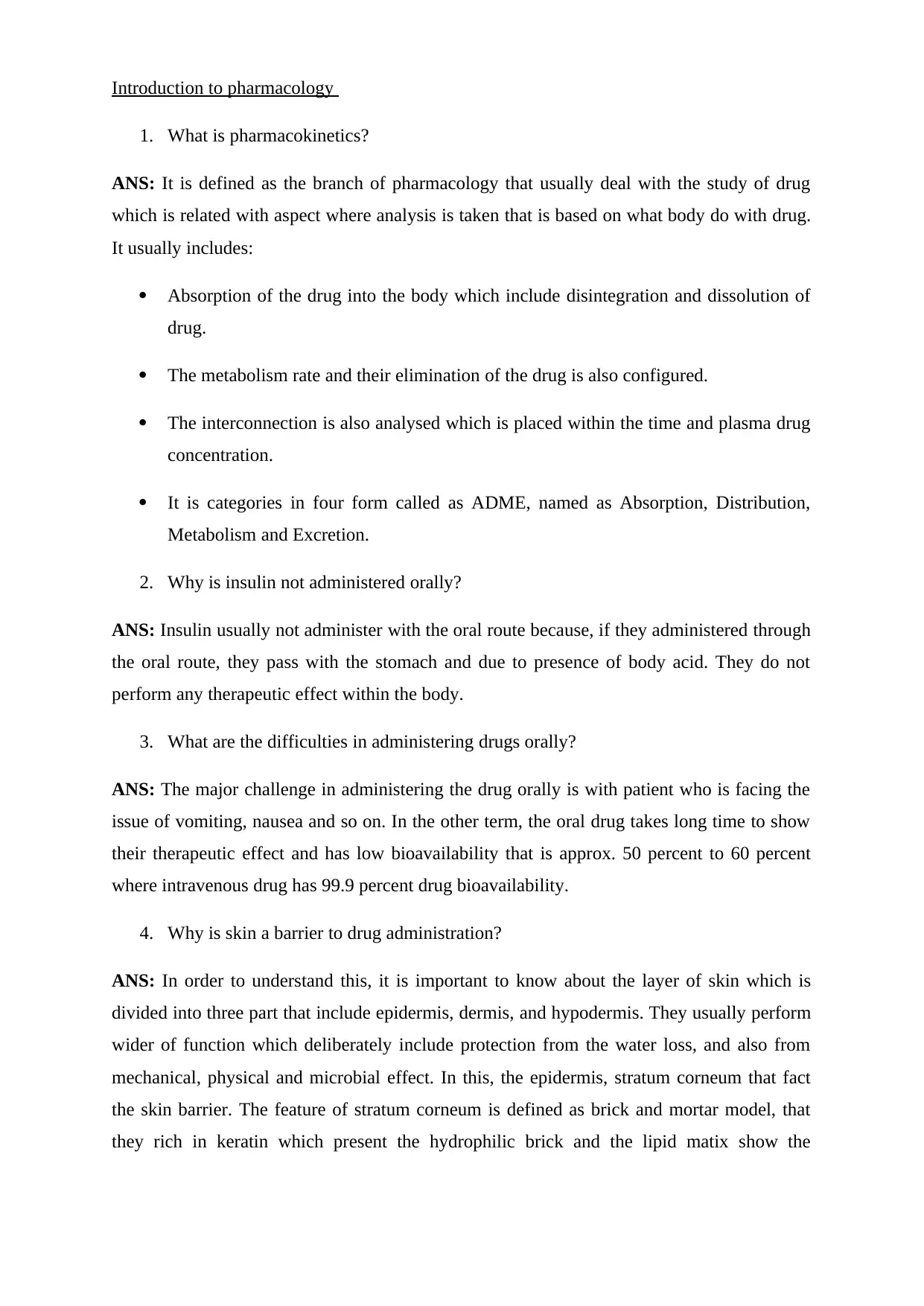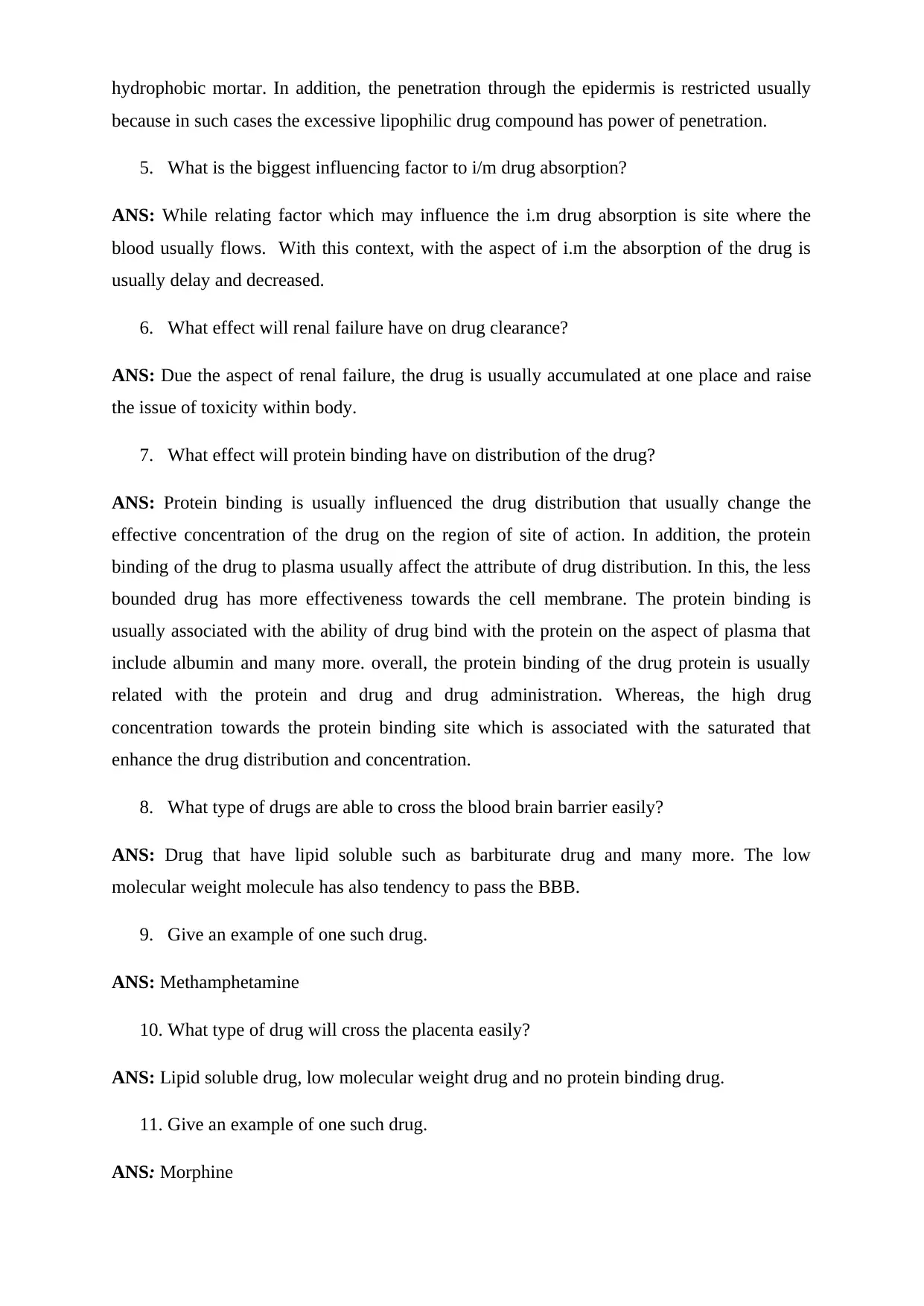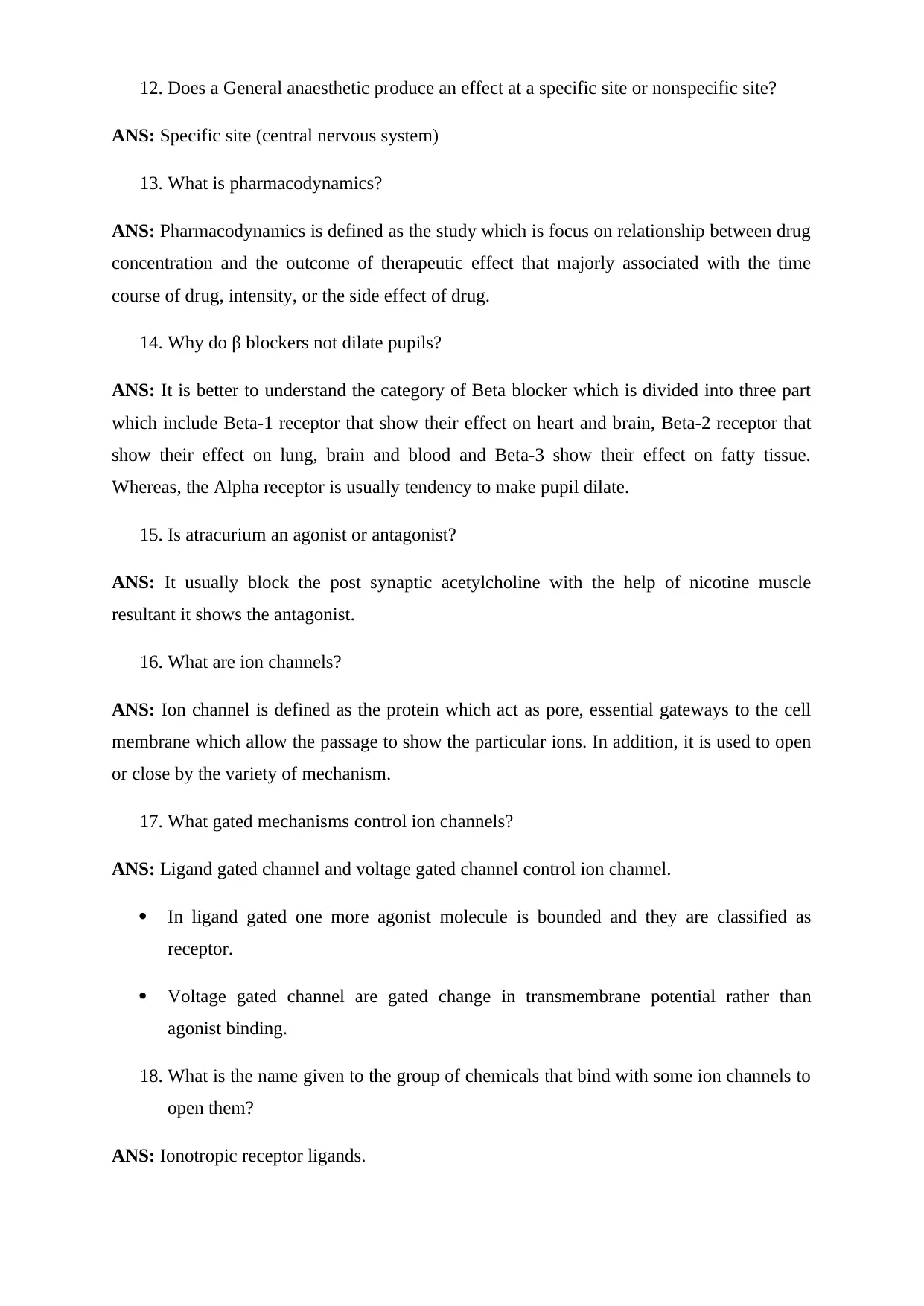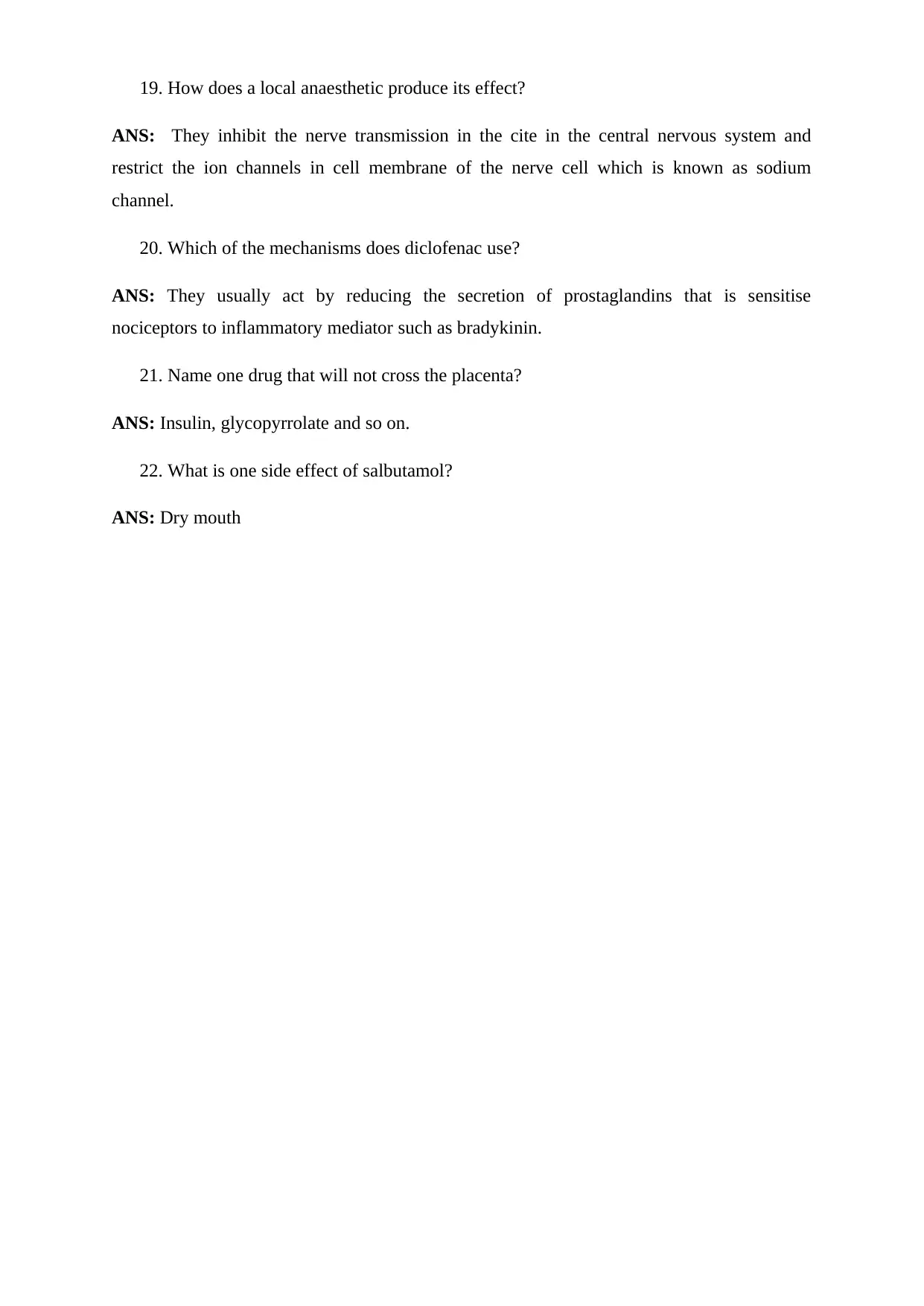Pharmacology: Understanding Drug Absorption, Distribution, Metabolism and Excretion
VerifiedAdded on 2023/06/12
|4
|1148
|96
AI Summary
This article provides an introduction to pharmacology, covering topics such as pharmacokinetics, drug administration challenges, skin as a barrier, protein binding, blood-brain barrier, ion channels, local anesthetics and more. It also includes examples of drugs that can cross the placenta and the blood-brain barrier, and the mechanisms of action of various drugs.
Contribute Materials
Your contribution can guide someone’s learning journey. Share your
documents today.

Introduction to pharmacology
1. What is pharmacokinetics?
ANS: It is defined as the branch of pharmacology that usually deal with the study of drug
which is related with aspect where analysis is taken that is based on what body do with drug.
It usually includes:
Absorption of the drug into the body which include disintegration and dissolution of
drug.
The metabolism rate and their elimination of the drug is also configured.
The interconnection is also analysed which is placed within the time and plasma drug
concentration.
It is categories in four form called as ADME, named as Absorption, Distribution,
Metabolism and Excretion.
2. Why is insulin not administered orally?
ANS: Insulin usually not administer with the oral route because, if they administered through
the oral route, they pass with the stomach and due to presence of body acid. They do not
perform any therapeutic effect within the body.
3. What are the difficulties in administering drugs orally?
ANS: The major challenge in administering the drug orally is with patient who is facing the
issue of vomiting, nausea and so on. In the other term, the oral drug takes long time to show
their therapeutic effect and has low bioavailability that is approx. 50 percent to 60 percent
where intravenous drug has 99.9 percent drug bioavailability.
4. Why is skin a barrier to drug administration?
ANS: In order to understand this, it is important to know about the layer of skin which is
divided into three part that include epidermis, dermis, and hypodermis. They usually perform
wider of function which deliberately include protection from the water loss, and also from
mechanical, physical and microbial effect. In this, the epidermis, stratum corneum that fact
the skin barrier. The feature of stratum corneum is defined as brick and mortar model, that
they rich in keratin which present the hydrophilic brick and the lipid matix show the
1. What is pharmacokinetics?
ANS: It is defined as the branch of pharmacology that usually deal with the study of drug
which is related with aspect where analysis is taken that is based on what body do with drug.
It usually includes:
Absorption of the drug into the body which include disintegration and dissolution of
drug.
The metabolism rate and their elimination of the drug is also configured.
The interconnection is also analysed which is placed within the time and plasma drug
concentration.
It is categories in four form called as ADME, named as Absorption, Distribution,
Metabolism and Excretion.
2. Why is insulin not administered orally?
ANS: Insulin usually not administer with the oral route because, if they administered through
the oral route, they pass with the stomach and due to presence of body acid. They do not
perform any therapeutic effect within the body.
3. What are the difficulties in administering drugs orally?
ANS: The major challenge in administering the drug orally is with patient who is facing the
issue of vomiting, nausea and so on. In the other term, the oral drug takes long time to show
their therapeutic effect and has low bioavailability that is approx. 50 percent to 60 percent
where intravenous drug has 99.9 percent drug bioavailability.
4. Why is skin a barrier to drug administration?
ANS: In order to understand this, it is important to know about the layer of skin which is
divided into three part that include epidermis, dermis, and hypodermis. They usually perform
wider of function which deliberately include protection from the water loss, and also from
mechanical, physical and microbial effect. In this, the epidermis, stratum corneum that fact
the skin barrier. The feature of stratum corneum is defined as brick and mortar model, that
they rich in keratin which present the hydrophilic brick and the lipid matix show the
Secure Best Marks with AI Grader
Need help grading? Try our AI Grader for instant feedback on your assignments.

hydrophobic mortar. In addition, the penetration through the epidermis is restricted usually
because in such cases the excessive lipophilic drug compound has power of penetration.
5. What is the biggest influencing factor to i/m drug absorption?
ANS: While relating factor which may influence the i.m drug absorption is site where the
blood usually flows. With this context, with the aspect of i.m the absorption of the drug is
usually delay and decreased.
6. What effect will renal failure have on drug clearance?
ANS: Due the aspect of renal failure, the drug is usually accumulated at one place and raise
the issue of toxicity within body.
7. What effect will protein binding have on distribution of the drug?
ANS: Protein binding is usually influenced the drug distribution that usually change the
effective concentration of the drug on the region of site of action. In addition, the protein
binding of the drug to plasma usually affect the attribute of drug distribution. In this, the less
bounded drug has more effectiveness towards the cell membrane. The protein binding is
usually associated with the ability of drug bind with the protein on the aspect of plasma that
include albumin and many more. overall, the protein binding of the drug protein is usually
related with the protein and drug and drug administration. Whereas, the high drug
concentration towards the protein binding site which is associated with the saturated that
enhance the drug distribution and concentration.
8. What type of drugs are able to cross the blood brain barrier easily?
ANS: Drug that have lipid soluble such as barbiturate drug and many more. The low
molecular weight molecule has also tendency to pass the BBB.
9. Give an example of one such drug.
ANS: Methamphetamine
10. What type of drug will cross the placenta easily?
ANS: Lipid soluble drug, low molecular weight drug and no protein binding drug.
11. Give an example of one such drug.
ANS: Morphine
because in such cases the excessive lipophilic drug compound has power of penetration.
5. What is the biggest influencing factor to i/m drug absorption?
ANS: While relating factor which may influence the i.m drug absorption is site where the
blood usually flows. With this context, with the aspect of i.m the absorption of the drug is
usually delay and decreased.
6. What effect will renal failure have on drug clearance?
ANS: Due the aspect of renal failure, the drug is usually accumulated at one place and raise
the issue of toxicity within body.
7. What effect will protein binding have on distribution of the drug?
ANS: Protein binding is usually influenced the drug distribution that usually change the
effective concentration of the drug on the region of site of action. In addition, the protein
binding of the drug to plasma usually affect the attribute of drug distribution. In this, the less
bounded drug has more effectiveness towards the cell membrane. The protein binding is
usually associated with the ability of drug bind with the protein on the aspect of plasma that
include albumin and many more. overall, the protein binding of the drug protein is usually
related with the protein and drug and drug administration. Whereas, the high drug
concentration towards the protein binding site which is associated with the saturated that
enhance the drug distribution and concentration.
8. What type of drugs are able to cross the blood brain barrier easily?
ANS: Drug that have lipid soluble such as barbiturate drug and many more. The low
molecular weight molecule has also tendency to pass the BBB.
9. Give an example of one such drug.
ANS: Methamphetamine
10. What type of drug will cross the placenta easily?
ANS: Lipid soluble drug, low molecular weight drug and no protein binding drug.
11. Give an example of one such drug.
ANS: Morphine

12. Does a General anaesthetic produce an effect at a specific site or nonspecific site?
ANS: Specific site (central nervous system)
13. What is pharmacodynamics?
ANS: Pharmacodynamics is defined as the study which is focus on relationship between drug
concentration and the outcome of therapeutic effect that majorly associated with the time
course of drug, intensity, or the side effect of drug.
14. Why do β blockers not dilate pupils?
ANS: It is better to understand the category of Beta blocker which is divided into three part
which include Beta-1 receptor that show their effect on heart and brain, Beta-2 receptor that
show their effect on lung, brain and blood and Beta-3 show their effect on fatty tissue.
Whereas, the Alpha receptor is usually tendency to make pupil dilate.
15. Is atracurium an agonist or antagonist?
ANS: It usually block the post synaptic acetylcholine with the help of nicotine muscle
resultant it shows the antagonist.
16. What are ion channels?
ANS: Ion channel is defined as the protein which act as pore, essential gateways to the cell
membrane which allow the passage to show the particular ions. In addition, it is used to open
or close by the variety of mechanism.
17. What gated mechanisms control ion channels?
ANS: Ligand gated channel and voltage gated channel control ion channel.
In ligand gated one more agonist molecule is bounded and they are classified as
receptor.
Voltage gated channel are gated change in transmembrane potential rather than
agonist binding.
18. What is the name given to the group of chemicals that bind with some ion channels to
open them?
ANS: Ionotropic receptor ligands.
ANS: Specific site (central nervous system)
13. What is pharmacodynamics?
ANS: Pharmacodynamics is defined as the study which is focus on relationship between drug
concentration and the outcome of therapeutic effect that majorly associated with the time
course of drug, intensity, or the side effect of drug.
14. Why do β blockers not dilate pupils?
ANS: It is better to understand the category of Beta blocker which is divided into three part
which include Beta-1 receptor that show their effect on heart and brain, Beta-2 receptor that
show their effect on lung, brain and blood and Beta-3 show their effect on fatty tissue.
Whereas, the Alpha receptor is usually tendency to make pupil dilate.
15. Is atracurium an agonist or antagonist?
ANS: It usually block the post synaptic acetylcholine with the help of nicotine muscle
resultant it shows the antagonist.
16. What are ion channels?
ANS: Ion channel is defined as the protein which act as pore, essential gateways to the cell
membrane which allow the passage to show the particular ions. In addition, it is used to open
or close by the variety of mechanism.
17. What gated mechanisms control ion channels?
ANS: Ligand gated channel and voltage gated channel control ion channel.
In ligand gated one more agonist molecule is bounded and they are classified as
receptor.
Voltage gated channel are gated change in transmembrane potential rather than
agonist binding.
18. What is the name given to the group of chemicals that bind with some ion channels to
open them?
ANS: Ionotropic receptor ligands.

19. How does a local anaesthetic produce its effect?
ANS: They inhibit the nerve transmission in the cite in the central nervous system and
restrict the ion channels in cell membrane of the nerve cell which is known as sodium
channel.
20. Which of the mechanisms does diclofenac use?
ANS: They usually act by reducing the secretion of prostaglandins that is sensitise
nociceptors to inflammatory mediator such as bradykinin.
21. Name one drug that will not cross the placenta?
ANS: Insulin, glycopyrrolate and so on.
22. What is one side effect of salbutamol?
ANS: Dry mouth
ANS: They inhibit the nerve transmission in the cite in the central nervous system and
restrict the ion channels in cell membrane of the nerve cell which is known as sodium
channel.
20. Which of the mechanisms does diclofenac use?
ANS: They usually act by reducing the secretion of prostaglandins that is sensitise
nociceptors to inflammatory mediator such as bradykinin.
21. Name one drug that will not cross the placenta?
ANS: Insulin, glycopyrrolate and so on.
22. What is one side effect of salbutamol?
ANS: Dry mouth
1 out of 4
Related Documents
Your All-in-One AI-Powered Toolkit for Academic Success.
+13062052269
info@desklib.com
Available 24*7 on WhatsApp / Email
![[object Object]](/_next/static/media/star-bottom.7253800d.svg)
Unlock your academic potential
© 2024 | Zucol Services PVT LTD | All rights reserved.
